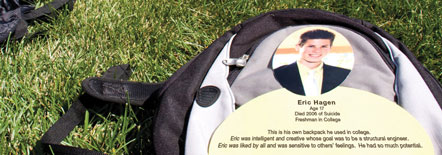
Breaking the Silence of Suicide
By Kristin Blank
In honor of National Suicide Prevention Week 2010, SAMHSA hosted a unique event called Send Silence Packing. Sponsored by the national nonprofit student organization Active Minds, the outdoor display of 1,100 backpacks represents the 1,100 college students who die by suicide each year. The story of a family’s tragedy accompanied each backpack.
“The statistics on suicide are chilling, but nothing so chilling as the sight of those 1,100 knapsacks, as colorful as they are to catch your eye,” said Frances M. Harding, Director of SAMHSA’s Center for Mental Health Services (CMHS).
In addition to the powerful outdoor display, SAMHSA sponsored an inservice called “Prevention Works: Suicide Prevention Successes” where attendees learned about the different SAMHSA suicide prevention grant programs working to save lives across the Nation.
Representatives from the following SAMHSA grant programs attended the event:
- Campus Suicide Prevention Program
- State/Tribal Youth Suicide Prevention Program
- National Suicide Prevention Lifeline
- Suicide Prevention Resource Center
- Native Aspirations.
“Every suicide is a tragedy, and every suicide can be prevented,” said Eileen Zeller, M.P.H., a public health advisor at CMHS.
SAMHSA invited Alison Malmon, founder and executive director of Active Minds, to share the story of how she came to start the group in 2001. “I lost my brother Brian to suicide when he was just 22. I was a freshman in college when he died,” Ms. Malmon said.
She related Brian’s story—he was a popular, active high school student who went on to become a popular, active college student. When he was a senior, though, he went to the campus counseling services with signs of depression and anxiety. Brian was diagnosed with schizoaffective disorder—the symptoms of which he’d hidden since freshman year.
After a year and a half at home and in counseling, Brian took his own life. “I had always been Alison of Alison and Brian, and now it was just me—I wondered, who am I?” Ms. Malmon said.
Knowing that her brother had felt ashamed and embarrassed to talk about his mental health struggles, Ms. Malmon started Active Minds in order to engage students in mental health education. Today, 272 Active Minds chapters operate on college campuses nationwide. “Our goal is suicide prevention, first and foremost,” she said.
The Send Silence Packing display uses backpacks that have been donated by families and friends who have lost someone to suicide. They can submit their loved one’s story as well. In spring 2010, the display traveled to 10 college campuses, including SAMHSA grantee the University of Nebraska at Kearney (see SAMHSA News, May/June 2009 for details about their program).
“The more bags we unloaded, the more overwhelming and poignant the task,” said Estelle Bowman from CMHS. “It reminded me how important it is to reduce the number of deaths by suicide on college campuses.”
Another speaker at the event was Marshall Ellis, M.P.A., from CrisisLink, one of SAMHSA’s National Suicide Prevention Lifeline call centers. He described how additional funds received from SAMHSA in early 2010 have allowed their services to expand.
CrisisLink has been able to:
- Add a second overnight crisis counselor for 4 hours each night.
- Double the number of hotline work stations to allow an increase in daytime staffing by volunteer crisis counselors.
- Create an online training resource for crisis counselors and to share with the network of National Suicide Prevention Lifeline crisis centers.
- Expand followup procedures for suicidal callers to provide better support in days and weeks following the initial call.
To enhance followup services, CrisisLink is participating in a pilot program for the Lifeline involving the use of text messaging.
“We must end our silence because we know that suicide is a preventable tragedy,” said Ms. Harding. “We must end our silence by sharing prevention successes and sharing what we have learned with one another.”
Learn more about Active Minds. Find out more about SAMHSA’s suicide prevention activities.
SAMHSA’s Lifeline has answered more than 2 million calls since it was established in January 2005. Lifeline provides free, 24-hour, confidential help to anyone in suicidal crisis or emotional distress.